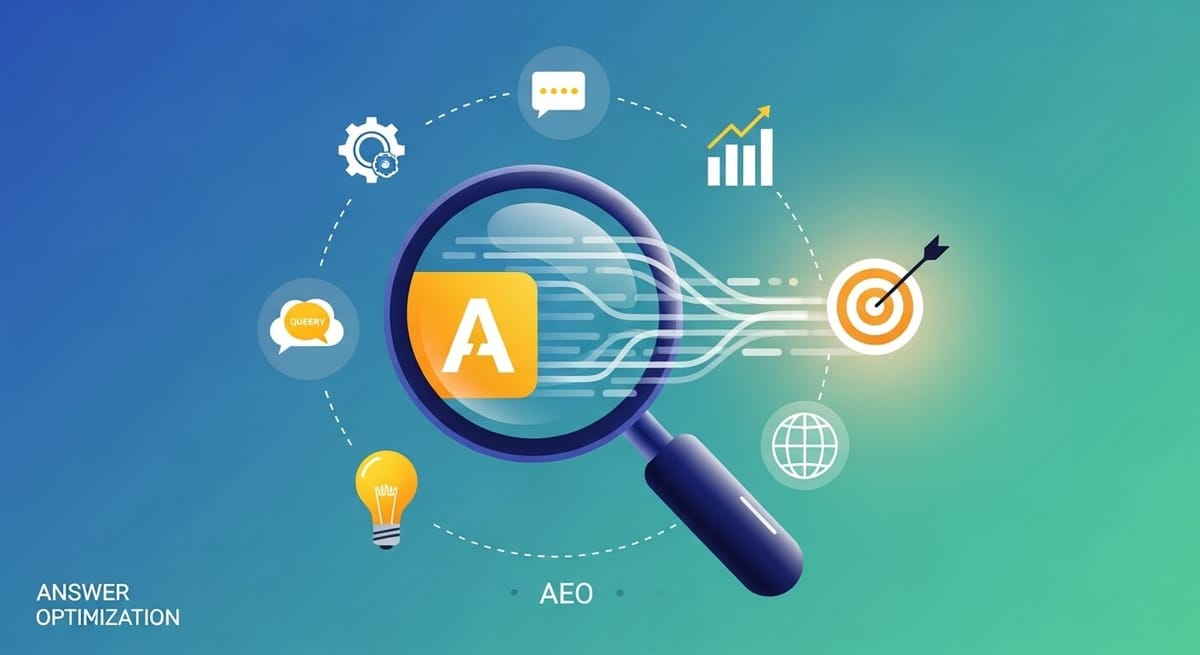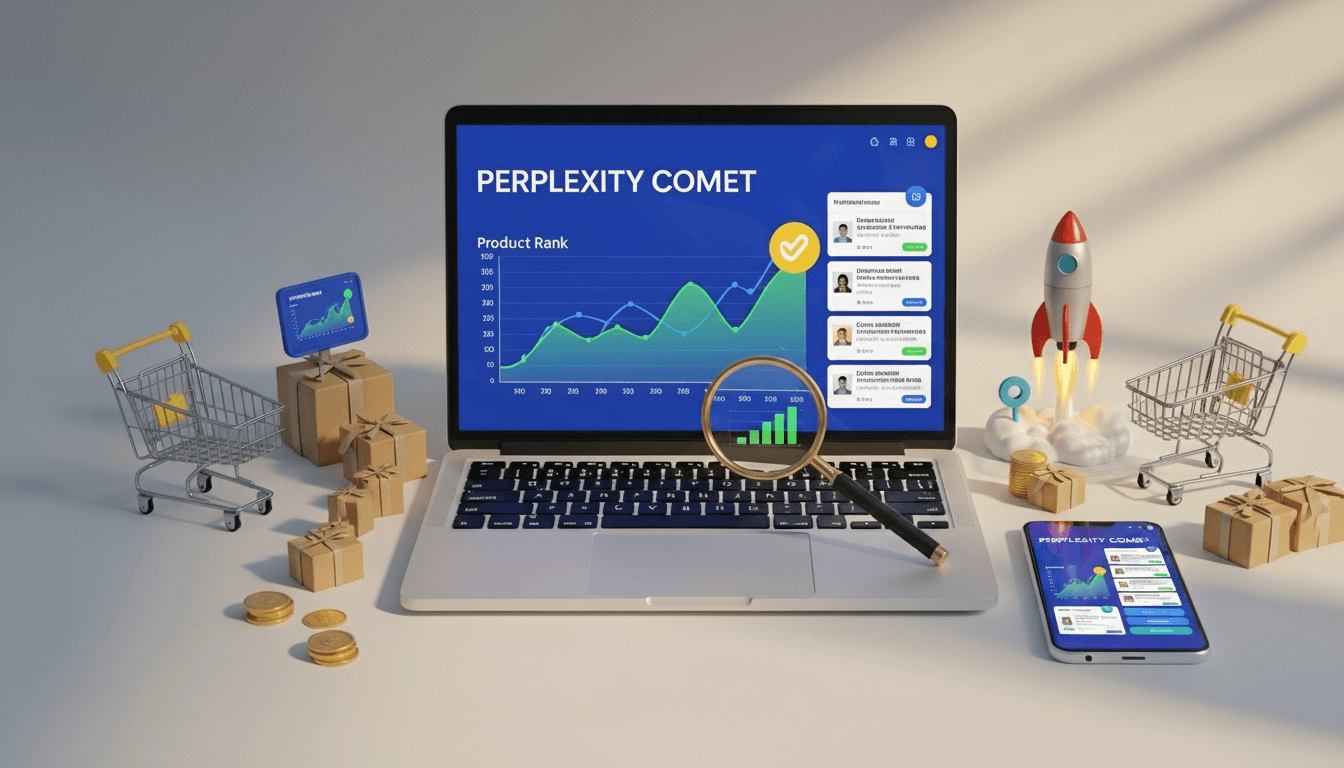How to Do E-commerce Answer Engine Optimization

Answer Engine Optimization (AEO) for E-commerce ensures your products appear when shoppers ask AI platforms like ChatGPT, Perplexity, and Google's AI Overview shopping questions like "best wireless headphones under $100" or "where to buy organic baby clothes online."
Unlike traditional SEO that ranks your store in search results, AEO gets your specific products recommended directly by AI. This comprehensive guide provides step-by-step strategies for Shopify, and WooCommerce stores to optimize product catalogs, improve AI visibility, and drive measurable sales from AI-referred traffic.
What is E-commerce Answer Engine Optimization?
E-commerce AEO is a specialized discipline that optimizes your product catalog, store structure, and product data so AI platforms understand, index, and recommend your products to shoppers asking shopping-related questions.
Traditional SEO for E-commerce:
- Optimizes store pages to rank in Google search
- Targets keywords like "running shoes" or "laptop deals"
- Drives traffic to your category pages
- Success measured in rankings and clicks
E-commerce AEO:
- Optimizes product data for AI recommendation engines
- Targets shopping queries like "best running shoes for flat feet under $150"
- Gets specific products recommended directly to shoppers
- Success measured in product mentions, AI-referred conversions, and revenue
Why E-commerce AEO Matters in 2025
- Zero-Click Product Discovery: ~60% of shopping queries in 2025 result in AI recommendations, as shoppers get product suggestions directly from ChatGPT or Perplexity without visiting Google first.
- Purchase Influence: AI product recommendations drive 50-60% of purchase decisions, especially for online retailers.
- Brand Authority: Products cited by AI boost recognition and credibility for your store, even without direct clicks.
- Rising Shopping Platforms: Answer engines like Perplexity and ChatGPT provide direct product recommendations, reducing reliance on traditional search.
Ecommerce AEO ensures your brand remains visible in this evolving landscape, complementing SEO to capture users across traditional, AI, and voice-based platforms.
What are the Core Principles of E-commerce AEO
- Token Efficiency: Minimize redundancy in product descriptions for concise, clear content that AI can process effectively.
- Embedding Relevance: Use semantic coherence to align product content with relevant shopping queries.
- Contextual Authority: Establish product expertise and consistency to gain AI trust in your category.
- Canonical Clarity: Use unambiguous, standard product terms to prevent misinterpretation (e.g., "wireless headphones" not "TWS audio devices").
- Prompt Compatibility: Structure product content to match common shopping queries like "best [product] for [use case]".
Key Strategies for E-commerce AEO Success
1.Understand Shopping Intent
Steps: Use tools like AnswerThePublic, AlsoAsked.com, SEMrush, or Reddit/Quora to identify real shopper questions. Categorize by intent (product research, comparison, purchase) and plan content accordingly.
E-commerce Example: For an electronics store, target "What are the best wireless headphones for working from home?" with a detailed product comparison guide.
Tools: AnswerThePublic, SEMrush, Reddit (r/BuyItForLife), Amazon Q&A sections.
Tip: Test shopping queries on ChatGPT or Perplexity to analyze current AI product recommendations and identify gaps where your products should appear.
2. Create Comprehensive Product Answer Hubs
Steps: Use shopping questions as H2 headers, provide a 40-60 word product answer upfront, then expand with specifications, comparisons, use cases, and FAQs. Build product hubs linking related items.
E-commerce Example: For "What are the best standing desks for home offices?", include product definitions, comparison table of your top desks (price, features, dimensions), customer use cases, and FAQs about assembly and shipping.
Tools: Surfer SEO, Notion.
Tip: Ensure standalone product summaries for AI extraction—AI platforms pull concise answers to recommend to shoppers.
3. Use Long-Tail Shopping Queries and Conversational Language
Steps: Target phrases like "Where to buy ergonomic office chairs under $300?" and write product descriptions in a natural, conversational tone that matches how shoppers speak.
E-commerce Example: Answer with product options organized by price point, and anticipate follow-up questions like "Do these chairs ship fully assembled?"
Tools: Google's "People Also Ask," Hemingway App.
Tip: Optimize product pages for voice shopping with natural speech patterns—"best noise-cancelling headphones for airplanes" not "premium ANC headphones."
4. Implement Product Schema Markup
Steps: Apply Product, Offer, Review, and FAQPage schemas using Google's Structured Data Markup Helper. Test with Google's Rich Results Test.
E-commerce Example: Mark up product pages with price, availability, ratings, and shipping details. Add HowTo schema for product setup guides.
Tools: Schema.org, SEMrush Site Audit, Shopify schema apps, WooCommerce schema plugins.
Tip: Prioritize mobile-friendly product schemas for voice AI shopping assistants.
5. Optimize for Featured Snippets
Steps: Place concise product answers (100-200 words) at the top of product pages and buying guides, using comparison tables or bulleted feature lists. Analyze competitors' snippets with SEMrush.
E-commerce Example: For "Best wireless earbuds for running", create a comparison table showing your top 3 products with features, prices, and "best for" recommendations.
Tools: SEMrush, Ahrefs.
Tip: Target "best [product]" or "where to buy [product]" queries and refresh product content regularly to maintain snippet positions.
6. Incorporate Product Visuals and Summaries
Steps: Add product images, comparison infographics, or specification charts with descriptive alt text. Include key product benefit summaries upfront.
E-commerce Example: An infographic comparing "Standing Desk Features: Manual vs. Electric vs. Converter" with icons showing height range, weight capacity, and price points.
Tools: Canva, Piktochart.
Tip: Align product visuals with text for multimodal AI extraction—AI platforms increasingly use images to understand products.
7. Build E-E-A-T (Expertise, Authoritativeness, Trustworthiness)
Steps: Showcase product expertise, cite product testing data, and include customer reviews. Add "experience markers" like "We've sold 5,000+ standing desks to remote workers."
E-commerce Example: Include store credentials ("Authorized dealer since 2018"), product testing methodologies, and link to third-party product reviews.
Tools: Customer review platforms, Google Scholar for industry research.
Tip: Build backlinks from reputable product review sites and industry blogs for product category authority.
8. Develop Entity-First Product Content
Steps: Define products clearly with standard terminology, use canonical product names, and link related product pages to form product ecosystems.
E-commerce Example: Link "What are noise-cancelling headphones?" to "Best Noise-Cancelling Headphones 2025" and "Wireless Headphones Buying Guide."
Tools: Yoast (WordPress), Shopify internal linking.
Tip: Focus on product entities (brand names, model numbers, categories) for knowledge graph inclusion—helps AI understand your product catalog structure.
9. Utilize Strategic Product FAQs
Steps: Create H2 FAQs (50-120 words) based on real customer questions from support emails, live chat, and product reviews. Include product comparison questions.
E-commerce Example: "Are these headphones compatible with iPhone and Android?" with detailed compatibility answer. "How does battery life compare to Sony WH-1000XM5?" with specific comparison.
Tools: FAQ schema generators, customer support ticket analysis.
Tip: Source product questions from Amazon Q&A sections and customer support logs—these reflect real shopping concerns.
10. Optimize Evergreen Product Content
Steps: Focus on product comparisons, buying guides, and how-to-choose content. Use patterns like problem-solution or feature-benefit matching.
E-commerce Example: "Wireless Headphones vs. Wired: For travel, wireless offers convenience and battery life of 20-30 hours. For studio work, wired provides zero-latency audio."
Tools: Notion, content calendar.
Tip: Add sales data and customer testimonials for credibility—"Our #1 seller for home offices" signals product authority to AI.
11. Build Product Authority Across Platforms
Steps: Claim Google Business Profile, optimize product listings on marketplaces (Amazon, eBay), encourage product reviews, and publish product comparison studies.
E-commerce Example: Use HARO to get your products featured in media gift guides and product roundups.
Tools: Google Business Profile, LinkedIn Publishing, marketplace seller tools.
Tip: Track third-party product citations—when blogs and review sites mention your products, AI platforms notice and gain confidence in recommending them.
12. Monitor and Refine Product Visibility
Steps: Track product mentions and shopping query visibility with AEO tools. Test product queries on AI platforms and iterate based on results. For e-commerce, use platforms like Answee for automated product catalog submissions and real-time product visibility monitoring across AI platforms.
E-commerce Example: If your standing desk isn't cited in ChatGPT for "best standing desks for small spaces," enhance product dimensions, add space-saving features to description, and improve product schema.
Tools: SEMrush, Ahrefs, Answee (e-commerce product optimization), Google Analytics 4.
Tip: Set KPIs like product recommendation frequency and shopping query coverage; use customer feedback to refine product descriptions.
Answee-Specific Features: Answee monitors crawler activity across 6 major AI platforms simultaneously, alerting you to product indexing issues in real-time. The platform automates product catalog extraction, data submission to answer engines, and provides rich visibility analytics showing which products get recommended most frequently.
What are the Key Players and Capabilities of AEO Ecosystem
Answer engines are LLM-powered platforms that deliver direct product recommendations to shoppers without requiring visits to multiple store websites. Unlike traditional search engines that provide links for exploration, answer engines parse shopping questions, extract relevant product information from various sources, and synthesize complete product recommendations.
These systems combine conventional search capabilities with large language models and Retrieval Augmented Generation (RAG) technology to generate and retrieve product answers from multiple sources simultaneously.
Major Answer Engine Platforms for E-commerce
Conversational AI Shopping Assistants: ChatGPT and Claude provide detailed product recommendations to complex shopping queries like "best laptop for video editing under $1500."
Specialized Shopping Platforms: Perplexity combines AI product synthesis with cited source attribution, creating a hybrid search-and-recommendation experience for shoppers.
Integrated Shopping Features: Google's AI Overviews deliver AI-generated product summaries at the top of search results, with shopping-specific features in AI mode.
Enterprise Shopping Companions: Microsoft Copilot integrates AI shopping assistance with comprehensive product search capabilities.
What Makes Answer Engines Powerful for Product Discovery
Answer engines excel because they can:
- Process and understand natural shopping queries with remarkable precision
- Simultaneously pull product information from multiple store sources
- Synthesize complex product comparisons into coherent recommendations
- Provide proper citations to original product sources (when available)
- Continuously improve product recommendations through user feedback
This evolution represents a fundamental change in how shoppers discover products online. Rather than clicking through multiple stores to compare products, shoppers now expect immediate, accurate product recommendations directly within the AI interface, making product visibility within these responses crucial for online retail success.
This is exactly where Answee becomes essential. Answer engines only recommend products they can fully understand—meaning your product data must be clean, structured, and machine-readable. Answee prepares your entire store for AI by extracting data directly from your sitemap.xml and converting it into an AI-optimized product knowledge base. This ensures answer engines can correctly interpret your products and include them in high-value recommendations.
What are the AI Ranking Variables for E-commerce
Leading AEO research platforms have developed comprehensive frameworks that break down the factors influencing product visibility across different AI models. Understanding these variables is essential before implementing any e-commerce AEO strategy.
Key factors include product data authority, topical relevance to shopping queries, semantic clarity in product descriptions, technical accessibility for AI crawlers, and product citation frequency across the training data that these AI systems use to generate recommendations.
Step-by-Step E-commerce AEO Implementation Framework
Based on insights from industry leaders and extensive testing with online retailers, here's a comprehensive five-step framework for effective e-commerce Answer Engine Optimization:
Step 1: Research and Strategic Analysis
Successful e-commerce AEO begins with thorough research of how AI systems currently perceive and recommend products in your category. Tools like Goodie and Answee provide comprehensive analysis including product visibility scores, shopping query coverage, and competitive product performance.
Shopping Query and Prompt Research
E-commerce AEO-focused research emphasizes shopping questions and natural language product queries over short keyword strings. This approach aligns with how shoppers interact with voice assistants and AI chatbots when seeking product advice.
Implementation Actions:
- Research specific product questions using "People Also Ask" boxes, AlsoAsked.com, and AnswerThePublic
- Focus on long-tail shopping queries like "best wireless headphones for travel under $200"
- Identify semantic product keywords and contextually relevant attributes using Google Keyword Planner and Semrush's Topic Research
- Mine Amazon Q&A sections and Reddit product communities for real shopper questions
- Leverage AI tools like ChatGPT with targeted prompts:
"Generate a comprehensive list of shopping questions and product discovery queries related to [YOUR PRODUCT CATEGORY] that online shoppers would ask AI assistants. Include:
- Product comparison questions
- Budget-constrained queries
- Use case specific questions
- Where to buy queries
- Feature and specification questions
Focus on conversational queries that mirror natural shopping speech patterns."Competitive and AI Product Recommendation Analysis
Understanding how your products and competitors' products are currently recommended—or overlooked—by AI systems is crucial for strategic planning. Analyzing which product content AI systems favor helps shape your optimization approach.
Implementation Actions:
- Track which shopping queries trigger AI-generated product recommendations
- Test queries like "best [your product] for [use case]" across ChatGPT, Perplexity, Claude
- Analyze AI product recommendation structures and preferred formats (comparison tables, feature lists)
- Identify competitors frequently appearing in AI product recommendations and examine their product data structure
- Test your store name and products across multiple AI assistants to understand current representation
Pro Tip: Create a product tracking spreadsheet including:
- Target shopping queries
- Products AI platforms currently recommend
- Your products' visibility vs. competitors
- Product data format and structure used by winners
- Schema markup and review volume of top-recommended products
Automated Solution: Answee monitors product visibility across 6 major AI platforms simultaneously (ChatGPT, Claude, Perplexity, Google AI Overview, Microsoft Copilot, and others), providing real-time alerts when your products gain or lose visibility in shopping recommendations.
Step 2: Product Content Creation and Optimization
Once research is complete, focus on creating product content specifically designed for AI consumption and product recommendations.
Product Data Quality and Structure
AI systems prioritize product content that is clear, comprehensive, and well-structured. High-performing product pages in the AI era require design for machine interpretation. Clear product formatting, semantic structure, and product attribute modularity help AI systems parse and extract product insights efficiently.
Implementation Actions:
- Begin product descriptions with a direct answer to "What is this product and who is it for?" within the first 50 words
- Use descriptive H2 and H3 headings formatted as shopping questions when appropriate ("Who Are These Headphones Best For?")
- Create logical product information hierarchy flowing from key benefits to detailed specifications
- Break up product text with bullet points, numbered feature lists, and specification tables
- Incorporate authoritative product citations, customer testimonials, and sales data
- Ensure product content aligns with E-E-A-T principles (Experience, Expertise, Authoritativeness, Trustworthiness)
Featured Snippets and Product Discovery Optimization
Featured snippets serve as prime real estate in search results and increasingly form the foundation for AI-generated product answers. Earning these positions requires product content that delivers concise, well-structured product recommendations tailored to shopping intent.
Implementation Actions:
- Structure critical product information in 40-50 word paragraphs optimized for featured snippets
- Format product features as numbered lists for "best [product] for [use case]" queries
- Create product comparison tables for "[product A] vs [product B]" or "best [product category]" queries
- Monitor "People Also Ask" product questions related to your categories and create dedicated product FAQ sections addressing each one
- Include comprehensive product FAQ sections using proper FAQPage schema markup
Product Content Template: For each main product, include:
- Clear product summary with key benefit (40-50 words)
- "Who this product is for" statement
- Feature-benefit bullet points
- Technical specifications table
- Use case scenarios
- Product comparison context
- FAQ section addressing shopping concerns
- Customer review highlights
Step 3: Technical E-commerce AEO Implementation
Technical elements play a crucial role in ensuring AI systems and crawlers can properly access and interpret your product catalog.
Product Schema Markup Implementation
Schema markup acts as a bridge between your product catalog and AI systems, providing structured, machine-readable product data that clarifies product attributes, pricing, availability, and customer sentiment. Proper implementation improves product visibility in AI recommendations.
Implementation Actions for E-commerce:
- Implement Product schema with complete product data (name, description, brand, SKU, image, price, availability)
- Use Offer schema for pricing, currency, shipping details, and stock status
- Apply Review and AggregateRating schema for customer feedback and ratings
- Implement FAQPage schema for product Q&A sections
- Use Breadcrumb schema for product category hierarchy
- Consider the emerging /llms.txt standard for AI-friendly product catalog indexing
Shopify Implementation:
- Most themes include basic Product schema
- Enhance with apps like Schema Plus for E-commerce or JSON-LD for SEO
- Answee automatically validates and enhances product schema across your entire Shopify catalog
How to Track AEO Performance
E-commerce AEO metrics focus on product visibility and shopping conversions in AI responses, differing from SEO's click-based metrics.
Key E-commerce Metrics
Product Visibility:
- Product mention frequency in AI responses
- Shopping query coverage (% of target queries where your products appear)
- Product recommendation placement (position 1-5 in AI answers)
- Sentiment analysis of product mentions (positive/negative context)
Shopping Engagement:
- Traffic from AI platforms (utm_source=chatgpt.com, perplexity.ai, ai.google.com)
- Bounce rate from AI-referred product traffic
- Time on product pages from AI sources
- Add-to-cart rate from AI recommendations
E-Commerce Conversions:
- Revenue attributed to AI product recommendations
- Conversion rate of AI-referred traffic vs. organic search
- Average order value from AI discovery
- Product return rates from AI recommendations (quality indicator)
Competitive Intelligence:
- Competitor product mention frequency
- Share of voice in key shopping queries
- Product category dominance by AI platform
E-commerce AEO Tools
E-commerce-Specific:
- Answee (purpose-built for online retailers) - Shopify/WooCommerce integration, automated product catalog optimization, real-time product visibility tracking across 6 AI platforms, shopping query monitoring, competitive product analysis
- Writesonic GEO - Brand visibility tracking with some product features
- Goodie AI - Shopping optimization features
Traditional Tools Adapted for E-commerce:
- SEMrush - Keyword and snippet tracking
- Ahrefs - Backlink and authority monitoring
- Google Analytics 4 - Traffic source attribution
Tip: Use e-commerce-specialized AEO platforms like Answee for automated product submissions, real-time product indexing alerts, and shopping query coverage analytics. Generic AEO tools lack product catalog integration and shopping-specific metrics.
Answee Advantage: Monitors crawler activity across 6 major AI platforms simultaneously (GPTBot, ClaudeBot, PerplexityBot, Google-Extended, OAI-SearchBot, ChatGPT-User), alerting you to product indexing issues in real-time. Provides automated product catalog extraction, data submission to answer engines, and rich product visibility analytics.
Make answer engines actually see your products. Install Answee and turn your sitemap.xml into rich, AI-friendly product data that boosts your visibility.
FAQs about the AEO Guide
Top tools include Writesonic, AI Monitor, Otterly.AI, BrandRank.AI, Answee (e-commerce), SEMrush, and Ahrefs. Many e-commerce platforms also provide automated submissions and analytics.
Yes. SEO drives traffic through rankings, while AEO ensures AI citations, capturing users across platforms. Together, they maximize visibility and authority.
Seek features like NLP support, question analysis, structured data tools, and AI-specific analytics. For e-commerce, look for automated submissions, quota monitoring, and direct search engine integrations.
- Target: SEO targets SERPs; AEO targets LLMs.
- Output: SEO delivers links; AEO delivers cited text.
- Metrics: SEO tracks clicks; AEO tracks citations and visibility.
- Intent: SEO focuses on navigational/transactional; AEO targets informational/discovery.
Definitions, FAQs, comparisons, how-tos, technical documentation, and data-driven articles perform best as they align with AI’s need for structured, factual content.
Use detailed product descriptions, structured FAQs, Product Schema, and comparison guides. Tools like Answee automate submissions and track performance across AI platforms.




